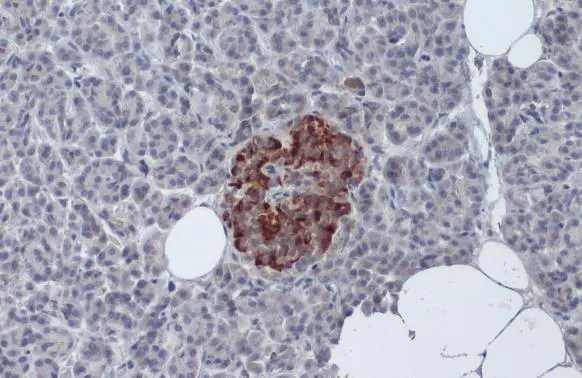
Insulin antibody detects Insulin protein at cytoplasm by immunohistochemical analysis. Sample: Paraffin-embedded human pancreas. Insulin stained by Insulin antibody (GTX27842) diluted at 1:50. Antigen Retrieval: Citrate buffer, pH 6.0, 15 min
Insulin antibody
GTX27842
ApplicationsImmunoFluorescence, ImmunoCytoChemistry, ImmunoHistoChemistry, ImmunoHistoChemistry Frozen, ImmunoHistoChemistry Paraffin
Product group Antibodies
TargetINS
Overview
- SupplierGeneTex
- Product NameInsulin antibody
- Delivery Days Customer9
- Application Supplier NoteFor IHC/ICC: Use at a dilution of 1:50-1:100. Prolonged fixation in buffered formalin can destroy the epitope. Optimal dilutions/concentrations should be determined by the end user.
- ApplicationsImmunoFluorescence, ImmunoCytoChemistry, ImmunoHistoChemistry, ImmunoHistoChemistry Frozen, ImmunoHistoChemistry Paraffin
- CertificationResearch Use Only
- ClonalityPolyclonal
- Concentration0.2 mg/ml
- ConjugateUnconjugated
- Gene ID3630
- Target nameINS
- Target descriptioninsulin
- Target synonymsIDDM; IDDM1; IDDM2; ILPR; insulin; IRDN; MODY10; PNDM4; preproinsulin; proinsulin
- HostGuinea Pig
- IsotypeIgG
- Protein IDP01308
- Protein NameInsulin
- Scientific DescriptionAfter removal of the precursor signal peptide, proinsulin is post-translationally cleaved into three peptides: the B chain and A chain peptides, which are covalently linked via two disulfide bonds to form insulin, and C-peptide. Binding of insulin to the insulin receptor (INSR) stimulates glucose uptake. A multitude of mutant alleles with phenotypic effects have been identified. There is a read-through gene, INS-IGF2, which overlaps with this gene at the 5 region and with the IGF2 gene at the 3 region. Alternative splicing results in multiple transcript variants. [provided by RefSeq, Jun 2010]
- Storage Instruction2°C to 8°C
- UNSPSC12352203
References
- Transcriptional activation of the Myc gene by glucose in beta-cells requires a ChREBP-dependent 3-D chromatin interaction between the Myc and Pvt1 genes.Read more
- Modulation of Unfolded Protein Response Restores Survival and Function of beta-Cells Exposed to the Endocrine Disruptor Bisphenol A.Read more
- Impact of biotin supplemented diet on mouse pancreatic islet beta-cell mass expansion and glucose induced electrical activity.Read more
- Donor-Specific Regulatory T Cell-Mediated Immune Tolerance in an Intrahepatic Murine Allogeneic Islet Transplantation Model with Short-Term Anti-CD154 mAb Single Treatment. Lee SJ et al., 2020 Jan-Dec, Cell TransplantRead more
- Human pancreatic afferent and efferent nerves: mapping and 3-D illustration of exocrine, endocrine, and adipose innervation. Chien HJ et al., 2019 Nov 1, Am J Physiol Gastrointest Liver PhysiolRead more
- Pancreatic prolactin receptor signaling regulates maternal glucose homeostasis. Nteeba J et al., 2019 Feb 1, J EndocrinolRead more
- Pancreatic neuro-insular network in young mice revealed by 3D panoramic histology. Tang SC et al., 2018 Jan, DiabetologiaRead more
- Human pancreatic neuro-insular network in health and fatty infiltration. Tang SC et al., 2018 Jan, DiabetologiaRead more
- An inhibitor of fibroblast growth factor receptor-1 (FGFR1) promotes late-stage terminal differentiation from NGN3+ pancreatic endocrine progenitors. Yamashita-Sugahara Y et al., 2016 Oct 27, Sci RepRead more
- PanIN-associated pericyte, glial, and islet remodeling in mice revealed by 3D pancreatic duct lesion histology. Lin PY et al., 2016 Sep 1, Am J Physiol Gastrointest Liver PhysiolRead more



![IHC-P analysis of human pancreas tissue using GTX27761 C-Peptide antibody [C-PEP-01].](https://www.genetex.com/upload/website/prouct_img/normal/GTX27761/GTX27761_20191025_AP_003_195_w_23060722_634.webp)